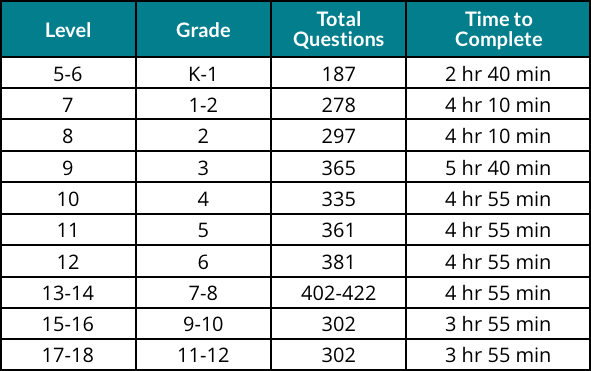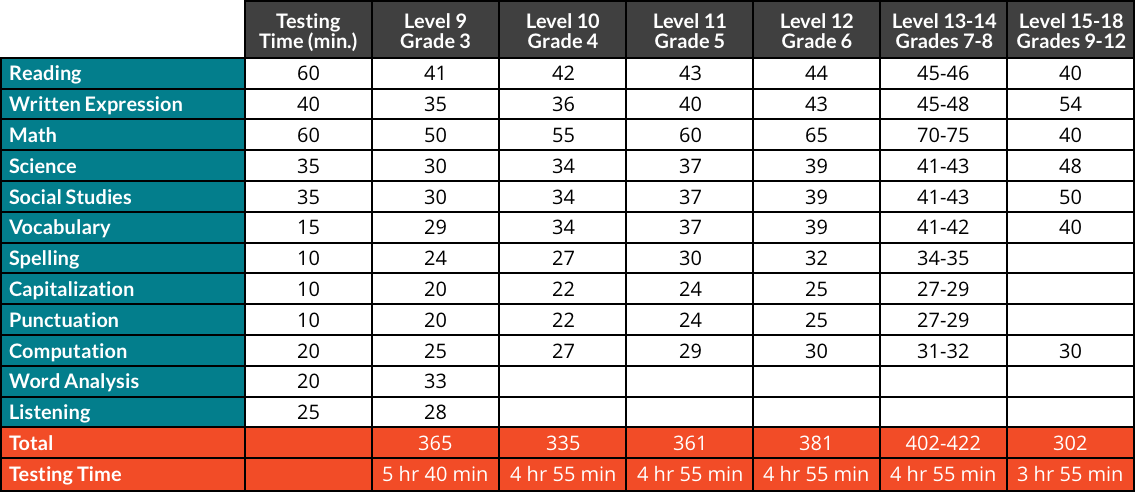 Iowa Assessments Test Number of Questions per Grade Level Chart" />
Iowa Assessments Test Number of Questions per Grade Level Chart" />The Iowa Assessments is a group-administered achievement test for grades K-12 which measures a student’s knowledge in subject areas that students have learned in school – reading, language arts, mathematics, science and social studies. The Iowa Assessments were released in the 2011-2012 school year and has replaced the Iowa Test of Basic Skills ® (ITBS ® ) and Iowa Test of Educational Development ® . The new exam format has been redesigned to better align the exam with the Iowa Common Core Standards. The test is also better aligned with other state standardized tests such as the Smarter Balanced Assessment exam.
The Iowa Assessments are used by school districts to assess a student’s college and career readiness. They are also becoming more prevalent as a component of determining whether a student will be admitted into a schools Talented and Gifted Program (TAG or GATE program).
Given that many schools rely solely on these test scores to place your child in the best programs, it would be highly beneficial to make sure that your child understands what each of the test areas is asking so that you could fix any issues before exam day.
Our full-length practice tests for the Iowa Assessments exam are in the same format as the actual exam. With our practice tests your child will become familiar with how the tests are formatted, the symbols used and the number of questions in each test area so that you can ensure they know what each test area is asking.
The Iowa Assessments exam is a group-administered aptitude test commonly given as an entrance exam into school's gifted programs.
To determine your child's aptitude, the Iowa Assessments exam assesses how your child does on things that are new to them. Therefore, the exam has many types of questions that your child would not have seen before. If your child understands the short set of directions that the administrator reads to your child prior to each section, they will probably do OK on the exam, but if they misunderstand the brief description, they can miss entire sections on the exam - due to a misunderstanding, not their intellect.
Many schools rely solely on these test scores to place your child in the best programs. It is, therefore, highly beneficial to make sure that your child understands what each of the test areas is asking for ahead of time.
Our full-length practice tests for the Iowa Assessments exam are in the same format as the actual exam. With our practice tests your child will become familiar with how the tests are formatted, the symbols used and the number of questions in each test area. This will insure that they know what each test area is asking.
The levels of the test go from 5 through 18 and are associated with the grade levels in the chart below:
 Iowa Assessments Test Number of Questions per Grade Level Chart" />
Iowa Assessments Test Number of Questions per Grade Level Chart" />
In the 2011-2012 school year Houghton Mifflin Harcourt replaced the Iowa test of basic skills (ITBS) and the Iowa Tests of Educational Development with the newly designed Iowa Assessments.
The new design was implemented to more closely follow the Common Core State Standards. New research was also done on the Iowa Assessments to connect performance to the ACT exam. This will allow Iowa Assessments scores to determine if a student is on track to be ready for college.
The testing sections of the Iowa Assessments Test are as follows for the following graded levels.
 Iowa Assessments Test Section Chart" />
Iowa Assessments Test Section Chart" />
The official guideline from the publisher is that students should not guess if they do not know the answer – that random guessing compromises the validity of the scores. However, the Iowa Assessments score is calculated based on the number of right answers and the student is not penalized for incorrect answers. As a parent looking for a high score, it is better for your child to answer all questions than leave an answer blank.
Scores on the Iowa Assessment can be compared with scores earned by a nationally representative sample of students who took the test (the norm group). The Iowa Assessment score that reflects this comparison is called a national percentile rank (NPR). If a student’s national percentile rank in Reading is 62, then the student scored as well as or higher on this subtest than 62% of his/her same-grade peers in the national norm group. The percentile ranks range from 1 to 99. The national average in all subtests is 50%.
Score reports generally contain a narrative that helps with understanding and/or interpreting the score results.